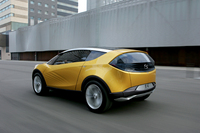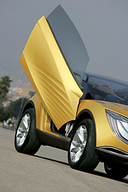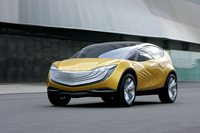Mazda Unveils Its Hakaze Concept at the Geneva Motor Show - VIDEO ENHANCED
Edited by Marc J. Rauch, Exec. VP & Co-Publisher
To watch a video intro of the Mazda Hakaze CLICK on the video window about half-way down the page
GENEVA - March 8, 2007: Last year Mazda wowed the show car world with a trilogy of design concepts that were talked about on three continents. From Europe's Sassou show car with its unique Shoji design principle and hidden features, to Tokyo Motor Show's Mazda Senku concept car, winner of the Grand Prix du Plus Beau Concept Car at the XXIst Festival Automobile International in 2006 in Paris, to North America's sports car study Mazda Kabura, winner of the Detroit Motor Show's Aesthetic and Innovation Award –Mazda Motor Corporation wrote another chapter in its global reputation for eye-catching, Zoom-Zoom designing.
The new show car season features four concepts from Mazda that express a new design language called Nagare, (pronounced na-ga-reh) developed by Mazda's new global design director, Laurens van den Acker. The word Nagare means "flow" and "the embodiment of movement" in Japanese and applying it to car design involved analyzing motion itself and how forces like wind and water move in nature. Natural flow lines are all around us - wind blowing shapes in sand, wave forms seen from above - and are literally symbolic of movement itself. Nagare, then, is the application of natural flow to automotive design that combines surface language and proportion to communicate movement in a new way.
"Through the success of the current generation of cars, Zoom-Zoom has managed to focus our company and delight our customers at the same time. Nagare builds on this newly regained confidence and gives it a unique and distinctive identity", says Laurens van den Acker.
 Mazda Nagare |
 Mazda Ryuga |
• For more about the Mazda Ryuga, including two great videos CLICK HERE
• For more about the Mazda Nagare, also with a great video CLICK HERE.
Now Nagare is coming to Europe with this season's third all-new concept car, the Mazda Hakaze, which was designed at Mazda's European Design Centre near Frankfurt, Germany. Mazda Hakaze is a compact crossover coupe with roadster feel. It combines the best attributes of three traditional types of cars. Part of its roof is removable, which gives a feel similar to a roadster; it is agile and fun to drive like a compact hatchback, and it has a high hip point and interior functionality like a compact SUV. It expresses Nagare "flow" on the outside with sand-dune like surface iteration, and combines these with shapes from machines that move through water or air. On the inside, it boasts "flowing" Nagare forms, natural surfaces and insightful functionality to meet the demands of adventurous lifestyles like kite-surfing.
 Mazda Hakaze |
Cross-Functionality for Concept Development
While the new Mazda Hakaze
design concept is a look into a possible future compact crossover vehicle
from Mazda, it is nonetheless a concept rooted in reality. It meets the
unmet needs of a growing compact segment trend towards SUV-like crossovers
in Europe, making it a valid proposal, despite its futuristic attributes.
To ensure Mazda Hakaze and all upcoming concepts from Mazda Motor Europe
are not merely flights of fancy, an Advanced Product Planning (APP) team
was assigned to Mazda Motor Europe's Research and Development (MRE) centre
in late 2004 with cross-functional team members from design, marketing and
engineering.
The APP team was responsible for the initial planning phase of the Hakaze project. This began with lifestyle and automotive trend research, and included spending time with"normal"consumers in Germany and the UK, to see exactly what kind of lifestyles people lead, and what kind of attitudes these customers have towards their cars. Combined with market data, it became clear that compact SUVs - those able to meet emerging and more active lifestyle trends - will become more popular over the next 10 years.
"Traditional segments in Europe are declining," said Benno Gaessler, Manager APP who, along with Stefan Meisterfeld, Assistant Manager APP, was responsible for analysis and strategy. "What the team found was that potential customers have emotional needs that are unfulfilled. They would like to drive a coupe, to drive a convertible, to drive a vehicle that is expressive. But these normally come with a very big price tag and expensive running costs. How we can fulfil these needs is what Hakaze is all about."
Exterior Design: The Compact Crossover Coupe with Roadster Feel
In Japanese, the word Hakaze (pronounced Hah-kah-zay) comes from "ha"
for "leaf" and "kaze" which means "wind," a fitting combination for a
vehicle that looks like it is effortlessly cutting through the air while
standing still. Mazda Hakaze has very compact proportions. At 4,420 mm, it
is roughly the same length (+15 mm) as the Mazda3 hatchback - which ensures
agile, sporty handling - but is wider (1,890 mm, + 135 mm), and taller
(1,560 mm, + 95 mm) with a high seating position, a very large glass area
and large suspension travel - all attributes usually associated with a
C-segment SUV.
This insightful package is clothed in a modernistic body work with no door handles and no mirrors - exterior cameras replace these - very compact proportions and flowing major feature lines and side textures that create a muscular and taught look. Mazda Hakaze has no B-pillar either and the rear two-thirds of the glass roof can be taken off in two parts and stored in a slide-out compartment in the rear bumper. Lowering the car's four frameless windows then converts the concept into a fun to drive, four-seat coupe with roadster feel.
 Mazda Hakaze |
All the concept's Nagare flow lines combine to visualize movement by making it seem as if the wind itself has etched natural flow lines into the car's surface. Even when parked, Mazda Hakaze looks as if it is moving - as if wind is blowing over the front wheel wells, down and along the side panels and across the bottom of the rear window.
Mazda Hakaze not only took its inspiration from Nagare natural flow, but also from technological objects like helicopters, speed boats, jetfighters. These are strongly related to flow and examples of human interface to fast movement through natural elements. The design team combined these kinds of forms with shapes directly moulded by flow in sand and water. Examples of this are Hakaze's glass roof cockpit and its 20-inch wheel design. The wheels use a mixture of forms inspired by sand dunes and propeller shapes to express flow and movement - including extensions of the spoke design into the tyre rubber bordering the wheel - and adds a three-dimensional depth to lend Mazda's new show car a modern sophistication.
"The Hakaze is an agile yet tough coupe that takes you wherever you want to go," says Luca Zollino. "Its design is also unique because of the unconventional shape of its hatch. The continuity of the beltline through the hatch allows us to close all the volumes above it: this together with a very angled and long windscreen enhances the compactness of its proportions."
Exterior Colour and Materials - Nagare Surface Treatment enhanced by
"flop" technique
Mazda Hakaze's exterior forms are combined with colours,
materials and surface treatment that also express Nagare flow. A desert
image is the source for its golden colour, reminiscent of a desert at
sunset.
"The exterior colour was selected to support the surface language, its articulation and its texture," says Maria Greger, Senior Designer for Colour and Materials, "so that the whole surface impression is one of natural flow. We want to have a feeling of sand. So if you look closer at the colour, you see small particles like sand."
The natural look to the exterior surface was further underscored by employing a "flop" technique in the colour treatment of all panels that are bent at an angle to form two sections with a smooth edge between them. The paint used for such panels was designed to give the upper part of the panel a more transparent feel, which is created by a transparent layer over the colour. Then the colour "flops" over towards a darker impression below the edge, an effect achieved by additives to the paint and by a slightly different use of particles in the paint. The final effect is similar to a sand dune or a wave in sand, which is lighter above and darker below.
Interior Design: A Natural Environment
 Mazda Hakaze |
"Nagare is visible on the interior in the main surfaces, which are a combination of gently flowing volumes with edges that slowly fade away," says Jo Stenuit, Assistant Chief Designer who, along with Masato Ogawa, Lead Designer from Hiroshima, designed Mazda Hakaze's interior. "Inspiration was taken from a dune landscape with the technical parts, like the steering column, being pushed into the surface like a shell that is partly covered in sand on the beach. Also the textures follow this gentle flow of form in a natural manner. All this creates a sensual feeling for the interior and makes sitting in Hakaze like sitting in a natural environment."
The interior design, and especially the instrument panel, is asymmetrical with a strong focus on the driver. The wrap-around cockpit features a long steering unit that gives a feeling of sportiness and depth. It has orange-lit meters on each side of the steering wheel - speedometer and tachometer - and in the centre of the steering column is an LCD screen with navigation information, images from the car's rear view and side cameras and warning indicators - all of which give an enhanced feeling of control to the driver. The centre of the steering wheel is fixed, only the rim and the lower arm can rotate. There are also unique sliding controls to the right of the driver on the centre console, which follow the three illuminated lines in the surface. These lines have a dune wave design to make it easy for the driver to slide his finger up or down along the surface. Doing so adjusts seat positions, heating, audio and multimedia devices, with light below the surface moving up or down with the finger. The wave strip furthest from the driver has the controls for the car's hard disc drive multimedia system and an LCD screen that electrically rises up and out of the dashboard surface on the passenger side. This screen can be turned by hand so the driver can also see it when the car is parked.
Data can be transferred to and from the car's computer with a personal "data shell", which is a further development of the USB stick concept used on the Mazda Sassou design car. It is a wireless device that allows the driver to open the car simply by carrying it in his pocket, and also allows him to save his personal driving settings and data from his home computer (route, music, movies). After getting in the car, the driver pushes the switch on the side of the "data shell" causing the connector to pop out (in way similar to a key). This he sticks into a designated slot in the centre console and it automatically downloads the stored information wireless using Bluetooth® technology and provides ignition. Once in place, the "data shell" also functions as the gear shift lever for the concept's automatic gearbox. Mazda Hakaze concept also has a wireless charging pad located in the glove box (also using Bluetooth®) to recharge the batteries of a mobile phone, PDA, camera or MP3 player. This insightful solution does away with annoying cables hanging everywhere, and keeps the device out of view and safe while it recharges automatically.
All of Mazda Hakaze's seats are mounted on the centre tunnel and are electrically adjustable, sliding fore and aft. For more room in the boot, the rear seats slide forward with their lower cushions under the front seats, which give ample space in the hatch for all kinds of gear necessary for a day at the beach. With the windows down and the top off, there is a true roadster feel wherever you happen to be sitting in the car.
Powertrain & Chassis Ready for Off-road Fun
The Mazda Hakaze design concept has been conceived to be equipped with
either a powerful DISI* petrol engine or a diesel engine. The MZR 2.3-litre
DISI petrol is a high-performance turbocharged engine with direct injection
that is coupled to Mazda's active torque-split all-wheel drive
transmission. This is Mazda's latest MZR petrol powertrain technology and
is an ideal match to the adventurous and fun nature of Mazda Hakaze. It
delivers high torque and power, 6-speed sport automatic transmission and
beach-ready four-wheel drive traction.
Combined with Mazda Hakaze's aerodynamic shape and lightweight body, the engine would not only be fun to drive, but would also use acceptable amounts of petrol. It has MacPherson front struts and multi-link rear suspension for agile, Zoom-Zoom handling, whether at the beach or in the city.
* Direct Injection Spark Ignition




